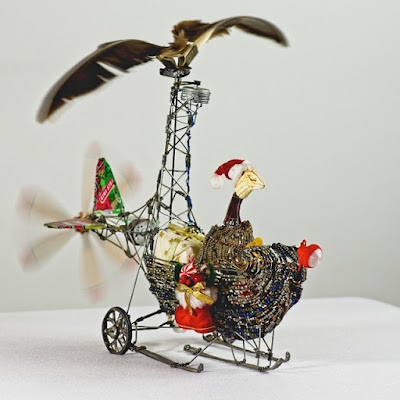This monster started off during a December holiday at the coast. Therefore the Christmas theme, as it was the season to be jolly. The framework was constructed on holiday, as well as the bead work. At the same time the flying surfaces were covered using a recycled cold drink can, chosen for its colours which matched the seasonal themes. The last holiday contributions were the rather large bird (gull?) feathers and a crab claw for Santa's head.
The monster was completed with a few technical aids which were not available on holiday. This involved casting lead wheels, a hub for the feather based rotors and a hub for the pusher propeller. The rotors also required some brass work and silver soldering. The original propeller was constructed with the outside of some large seed pods and aluminium tape. Problem was they disintegrated over the 10 or so years it took to get to this blog.
Last Christmas there was an attempt to do a video. For the video a rotor motor was added. This was a motor and pulley from an old CD, which was specified to run from 5 Volts. An old single cell Lithium Ion from a cell phone provided the energy and a rubber band transferred the power to the lead rotor hub. The pulley ratio (and band slip) combined with the mass of the rotor worked out well (by fluke), and provides a realistic slow rate of rotor rotation as expected of a large twin blade rotor. Nothing too frantic.
Next a lot of Christmas stuff was raided from the Christmas tree decorations. This included a miniature Christmas hat, small presents, socks, teddy bear and candy sticks with red and white stripes. Basically most of the colourful bits.
The last Christmas video didn't get published. Something to do with ignoring guests and getting too absorbed in my own projects. I modified my behaviour and enjoyed the holiday much more. The photo below shows the last year version of the monster with static pusher prop.
The next phase involved a long prop shaft and another ex-CD motor. This time the prop had a direct drive, and therefore spun much faster. Again realistic for a small pusher prop. The motor got a bright almost Gypsy paint job, which adds some interest to the tail. Unfortunately it also added some paint to the motor bearing and resulted in a cleaning job being required before the prop would spin again. Not everything goes smoothly during development. Typical result when the marketing department overrides the engineering department and wants to add unnecessary features to make it look better.
The final enhancement was to add the flashing navigation light in the front. The red-nose of the sleigh. This was activated by a 3D printed plastic cam driving a re-purposed micro switch from an old printer. The cam was glued to the wheel axle, which also had a crank to drive Santa's head. The flashing light proved to be challenging as it had to be bright enough to overcome the lighting required for the video. The holder was again printed on a 3D printer from PLA. Initially a small red LED was used in the white plastic holder. This was when the lighting situation became obvious. Take 2 involved using a high power LED (1 Watt) from a down-light which had an expired power supply (the preferred failure mode for LED lights). The plastic holder required a paint job to get the red-nose effect. This reduced the light output a bit, but it is visible in the video when the switch works.
The final video was enhanced by selecting music which was not one of the traditional Christmas carols. This was mainly due to copyright issues with music. The end result was much better than I anticipated. The details of the music are available in the comments section of the Youtube video. It takes a lot more effort to find music which one may use without paying royalties, but it does expose one to music which may otherwise stay obscure.





